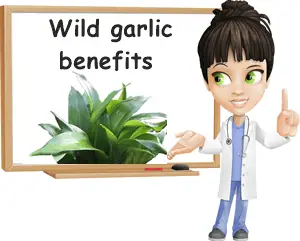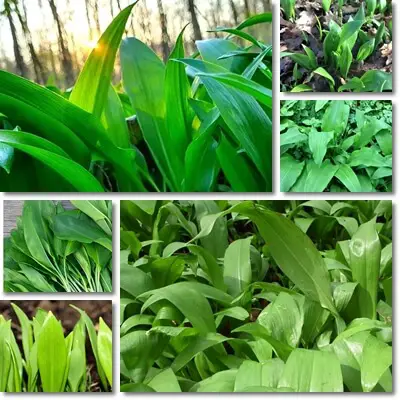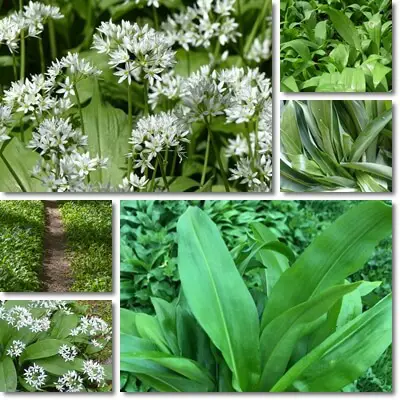Wild garlic is in full season right now and a great vegetable to try this spring. As its name suggests, wild garlic is related to cultivated garlic, and onions too. It gets its name from its garlic smell which is a strong identification marker for the plant. Wild garlic is a source of great nutrition and benefits for health, and just as good for you as common garlic.
What is wild garlic?
Wild garlic is many things. It is a naturally occurring edible plant, culinary vegetable, aromatic herb, invasive weed and medicinal herb. The plant goes by many common names including wild garlic, wood garlic, broadleaved garlic, bear’s garlic, bear’s leek, wild cowleek, ramsons and buckrams. The scientific name for wild garlic, Allium ursinum, indicates the plant is botanically related to both garlic and onions, belonging to the same order, family, subfamily and genus. It occurs naturally in forests across Europe, Asia and parts of North America.

Is wild garlic edible or poisonous?
Wild garlic is an edible plant, and it’s perfectly safe to eat. You can eat wild garlic both raw and cooked. What part of wild garlic can you eat? You can actually eat all of the plant. The leaves are most commonly eaten, but the stems, bulbs (roots) and flowers are edible too.
What does wild garlic look like?
Wild garlic is a leafy green plant that looks like it’s mostly made up of leaves. It grows to about 30 to 50 cm in height and fills the forest floor like a carpet. The leaves themselves arise individually from the ground and are elongated, broad and pointy, shaped like the head of a lance, with a prominent central leafstalk, a very particular appearance. Wild garlic leaves are a rich and intense light to deep green color, depending on the age of the plant, and glossy and smooth.
The root is bulbous, similar to that of garlic plants, while the flowers are tiny, white and star-shaped, with six petals each. Wild garlic flowers usually occur in clusters of six to twenty, and are all attached to one thin, green stem separate from the leaf stem.
When is wild garlic in season?
Wild garlic season lasts all spring. The plant is in season starting February or March and up until June at the latest. Flowering season is April through June. There may be some variation depending on the exact region the plant grows in, climate and yearly weather conditions. You can buy wild garlic at the farmers’ market, health food stores, and sometimes even at the supermarket, or get it from local farmers that grow it. Or you can forage for it in the forest where it grows abundantly.

What does wild garlic taste like?
Wild garlic has a pleasant, mildly pungent garlic flavor with fresh, green, grassy notes. It tastes like a leafy green salad vegetable with a garlic aroma. Compared to the taste which is mild, the odor is strong. The pungent garlic smell is a great way to identify the plant. You can eat wild garlic both fresh, or raw, and cooked. You can incorporate it in any recipe that welcomes an aromatic, garlicky leafy green such as pesto sauce, Italian focaccia flatbread, zucchini bread, seasonal spring salads, spaghetti, risottos, cream soups and more.
How do you identify wild garlic?
If you buy wild garlic, then you’re good. But if you are planning on foraging for it, then it’s important to know how to identify wild garlic and not confuse it with poisonous same-season plants that look just like it such as lily of the valley (Convallaria majalis). So a few helpful tips to help you with identification:
- Wild garlic leaves occur individually. Even though you’ll see wild garlic plants covering the whole forest floor like a carpet, if you look closely, each leaf arises separately from the ground.
- An unmistakable identification tip: rub a leaf between your fingers – if it instantly releases a garlic odor, then it’s wild garlic.
- Also learn how to identify wild garlic based on the pictures above and below.

What are the benefits of eating wild garlic?
Good for weight loss
Like most green leafy vegetables, wild garlic is very low in calories, and almost fat free, which makes it a good food for losing weight.
High content of vitamin K
Wild garlic is naturally high in vitamin K. Vitamin K has antibleeding effects, reduces inflammation markers in the body such as Interleukin 6, and helps preserve good bone density and prevent frail bones. While getting enough vitamin K in your diet is good for reducing risks of osteoporosis, it’s best to avoid eating too much of foods high in vitamin K such as leafy greens if you have a history of blood clots.
Wild garlic thins blood
Despite having vitamin K which favors blood coagulation, wild garlic is also a source of bioactive compounds with blood thinning properties. While this is good for cardiovascular health, it should be noted that eating wild garlic can enhance the effects of anticoagulant medication and increase risks of bleeding.
Source of vitamin C
Raw wild garlic has a good content of vitamin C with antioxidant, anti-inflammatory and antiaging benefits. However, the leaves must be consumed fresh to preserve their vitamin C content and associated benefits.
Benefits for bleeding gums
Wild garlic has vitamin K and vitamin C with antibleeding effects. Vitamin K which supports blood coagulation and vitamin C which ensures the integrity of blood vessel walls, preventing bleeding gums. Vitamin C in wild garlic further keeps gums healthy and ensures gums adherence to teeth which prevents tooth loss.
Combats constipation and regulates transit
Eating leafy green vegetables such as wild garlic provides dietary fiber and regulates transit time with benefits for constipation relief. Wild garlic also has a cleansing action and depurative effects.
Has anticancer properties
Wild garlic owes its flavor to organic sulfur compounds, the same compounds as in regular garlic. Organic sulfur compounds are scientifically proven to have anticancer effects such as antiproliferative and cytotoxic activities. In varieties of red garlic, pigmented anthocyanin antioxidants also have anticancer effects.
Low glycemic food
A leafy green naturally low in sugar, but with a good content of dietary fiber, wild garlic is rated low glycemic on the glycemic index scale. Low glycemic foods are good for blood sugar control in high blood sugar and diabetes.
Minimal effects of blood sugar
Wild garlic is a good food to eat if you are diabetic and are looking for foods to help you control your blood sugar levels. As a low glycemic food, it has minimal effects on blood sugar.
Antiparasitic properties
Organic sulfur compounds in wild garlic responsible for its taste and smell have natural insecticide properties and antiparasitic action against intestinal worms and other parasites.
Blood pressure lowering effects
Just like cultivated garlic, wild garlic has blood pressure lowering effects. The effects are owed to biologically active organic sulfur compounds and their metabolites (e.g. allicin). Studies show wild garlic is even better for high blood pressure than regular garlic (source).
Antimicrobial action
Wild garlic has scientifically proven antibacterial properties, and exhibits antibiotic activity, as well as enhances the effects of certain antibiotics. Studies show wild garlic preparations demonstrate strong antimicrobial activity against enteropathogenic strains such as Salmonella enteritidis, Escherichia coli, Proteus mirabilis and Enterococcus faecalis (source).
What are the side effects of wild garlic?
- Digestive upset. Wild garlic can potentially cause mild to moderate digestive upset if consumed in large amounts. Digestive upset is more likely in individuals with existing digestive conditions such as acid reflux, gastritis or a stomach ulcer. Symptoms may include: indigestion, nausea, vomiting sensation, heartburn, chest pain, loose stools, abdominal cramps, sweating.
- Bad breath. Wild garlic owes its flavor to the same kind of compounds responsible for the flavor profile of cultivated garlic and, as a result, causes bad breath, although not to the same extent as cultivated garlic which is much more pungent.
- Bad body smell. Eating garlic, leek, onion and wild garlic can cause a bad garlic body smell in some people. Sometimes the body odor is reminiscent of ammonia rather than garlic.
- Risk of misidentification. It’s easy to mistake wild garlic for several other poisonous plants, especially when the plants are still young. This is why it’s strongly advised to buy rather than forage for wild garlic if you do not have experience with forage plants in your area.
- Potential for allergic reactions. It is possible to experience an allergic reaction to wild garlic, or to other plants through pollen-driven cross-contamination, with the potential for anaphylactic shock.
- Medicine interactions. Bioactive compounds in wild garlic can interact with medication such as anticoagulants, antibiotics, blood pressure meds and more and either enhance or reduce their action.
